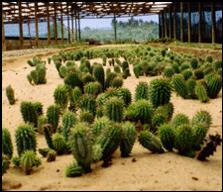A plant that can turn off your hungerIf you haven't heard of Hoodia yet, you soon will because it is being touted as the new miracle supplement for safe, effective weight loss. Hoodia gordonii, (Hoodia) is the botanical name for a cactus like plant that grows in Southern Africa. Scientists have recently isolated several compounds in this amazing plant that are responsible for dramatic weight loss. This all-natural appetite suppressant is also being applauded for containing no dangerous stimulants that caused adverse side effects associated with weight loss products of the last decade. Hoodia (or Hoodia Gordonii) is a South African dwelling plant that the San bushman have used to help endure long hunting expeditiions for generations. Hoodia Gordonii is actually a succulent not to be confused with a cactus. It belongs in the succulent family of Asclepiadaceae along with stapelia, stephanotis and vinca. There are approximately 20 species in the genus of Asclepiadaceae. As it grows it forms stemmed clumps approximately one foot high and bears, pale purple saucer-shaped flowers in shades of red or purple brown. Hoodia Gordonii was discovered and used by the San tribe from the Kalahari, South Africa, since prehistoric times. They chewed the bitter Hoodia plant twice a day to suppress hunger and thirst during long hunting trips. This plant contains the miracle molecule p57 that was recently translated into a obesity cure.
Hoodia's testimonialsThank you, the second Hoodia Gordonii shipment arrived yesterday April 4, 2005. By the way Hoodia is working very well I lost 12 lbs or (5.5 kg) in 2 months. Not dramatic but then again losing weight slowly is the best way to go. At this stage I don't pay attention to carbohydrates, fats, sugars and other diet fads. Regards - G D B (USA)
Hoodia researchScientists at the South African Center for Scientific and Industrial Research were the first to successfully prove that Hoodia contains a miracle molecule that suppresses the appetite. Later, a human clinical trial was conducted by scientists in Leicester England. A group of morbidly obese men and women participated. Half the group were given Hoodia and half were given a placebo. At the end of 15 days, the group on Hoodia had reduced their food intake by 1000 calories a day. Given the average daily diet is around 2200 calories, this was a stunning success. It has been established that the P57 molecule found in wild harvested Hoodia Gordonii works by mimicking the effect that glucose has on nerve cells in the brain in effect fooling the body into thinking it is full, even when it is not, thus curbing the appetite. Laboratory experiments show animals automatically restrict their food intake when taking hoodia orally. Rats, a species that will eat anything from meat and plants to indigestible fiber, lowered their dietary calorie intake to a degree that made them get thin when fed comparative amounts of hoodia.
Hoodia medications conjunctionThe Hoodia is an all-natural, herbal dietary supplement and there are no know adverse side effects relating to its use. No Caffeine. No Ephedra. So Hoodia is safe for us. Hoodia was eaten as a fresh food by the San tribe for thousands of years with zero side effects. ow long Hoodia take to work? With-in one hour after taking 2 capsules, Hoodia will suppress your appetite for around 4-8 hours.
Are all Hoodia products the same?The pure Hoodia that contains appetite suppressant qualities is only grown in one specific region in South Africa. If the Hoodia is from China, USA or any other part of the world and is not accompanied by a South African Government Certificate of Authenticity, the product is inferior and ineffective. All over the world, people are trying to buy hoodia, and there just isn't enough supply to go around. The succulent growers have been wiped out. The seed providers have virtually no inventory left. And since hoodia takes more than six years to grow to harvesting height, there's going to continue to be a great hoodia shortage until at least 2010, maybe beyond. So buying hoodia is very difficult. It's expensive. And, naturally, there are a lot of fakes on the market. Even now, there are only a few hundred acres of hoodia growing on commercial farms, and the plant is highly susceptible to being wiped out by rather mysterious conditions.

|